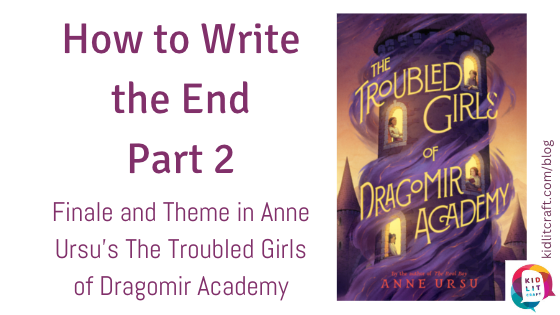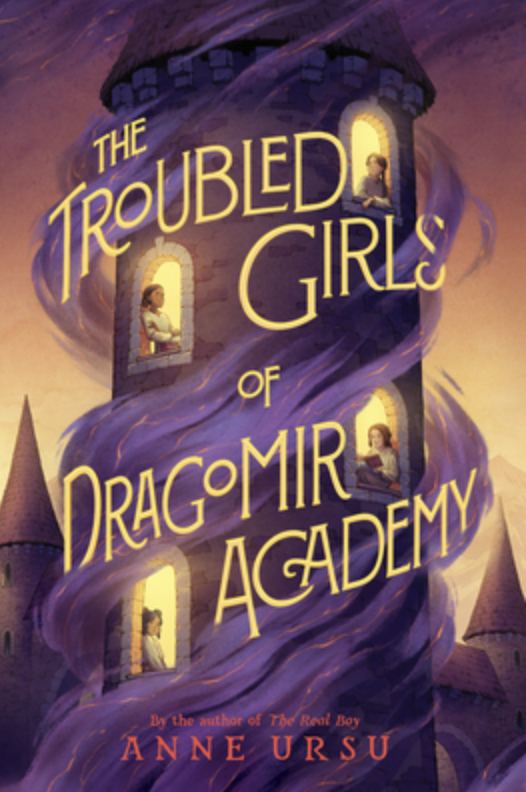craft post by Jen Jobart
This is the second in a series of posts that analyzes the ending of The Troubled Girls of Dragomir Academy by Anne Ursu.
If you haven’t read this book, please go read it now. It’s a delightful book and this post will completely ruin it for you.
You can read the first post in this series here.
From the All is Lost moment, right before Act 3 starts, to the Climax, The Troubled Girls of Dragomir Academy has followed each beat from Save the Cat, drawing readers in and compelling them to turn the page. But even after a stellar climax, the story isn’t done. There’s the opportunity to make the ending fully satisfying. Here’s how Ursu does it.
Denouement
The denouement provides closure to the story. It wraps up the external plot and the internal journeys of the main and other major characters.
The denouement also asks and answers the questions “What does all this mean and what am I going to do about it?” In this chapter (or chapters), the protagonist revisits the events of the story to find meaning in them.
I’ve noticed that denouements can be very dialogue and interiority heavy, with a little bit of action sprinkled in. In remembering my reading experiences, I perceive the endings of books to be very action oriented, so I was surprised to realize that’s not necessarily the case. I think that what I thought of as action was really me experiencing the same revelations that the main character, which feels interesting and requires active thought. So it’s probably the mental stimulation of connecting all of those dots that keeps me engaged. Plus I’m still kind of coming down from the climax. For those reasons, I think denouements seem to have more action than they actually do.
In the denouement of Troubled Girls, the conflict between Mayra and the headmaster enacts the theme of the book and showcases Marya’s emotional growth. It answers the question “What does this all mean? In this scene, Marya is using the same anger she had in the opening scene, but instead of keeping it in and repressing it, she’s controlling it to get information from the headmaster. Marya’s perceived greatest weakness (challenging important men and not respecting everything they say or do without question) turns out to be her greatest strength. This use of emotion is mirrored by the external plot which revolves around girls having their magic suppressed.
The second chapter of the denouement in Troubled Girls answers the questions “What am I going to do about it?” and “What’s next?” The girls of the Academy talk and think about what happened and what they will do now. The king agrees to keep the school open and let them run it, so they decide together how they will move forward.
Final image
The final scene should mirror the opening scene. It should show, not tell, what’s changed over the course of the book.
My friend Kristi Wright said, “I read somewhere that the ending seals your reader’s experience of your book.” What do you want your reader to be thinking as he or she walks away from the book? That’s what should be in your final image.
In the Troubled Girls, the girls are working together and have autonomy over their own futures. They have a plan for acknowledging their own power and using it for good.
Last paragraph
The very last paragraph of a book reminds us of the story’s theme.
In her book Beginnings, Middles & Ends, Nancy Kress writes, ”Often—not infallibly, but often—the last sentence or paragraph evokes the theme of the entire story…. Effective final paragraphs use action, symbol, or a character’s thoughts to seamlessly comment on the story’s meaning while also bringing the plot to a close.
Let’s look at the first paragraph of the book to see the initial image and theme there. Then we can compare to the final paragraph.
The first paragraph of Troubled Girls starts with storytelling and the lack of women’s stories in the history of Marya’s country:
There were few women pictured in the great tapestries of Illyria–besides the witches, of course. The tapestries depicted moments of heroism, epic battles of good and evil, of powerful sorcerers and brave noblemen protecting the kingdom from the monsters that had threatened it throughout its history.
Compare to the last paragraph:
There was more, so much more. Now that the doors were open, ideas were flooding into Marya’s head. They could learn the embroidery language. Madame Bandu could come and teach them to weave. They needed to tell their story in as many ways as they could. They needed to send letters, tell stories, weave, and embroider. They needed to tell the truth, to record it in a way that people would keep it.
The last sentence of Troubled Girls is:
They were the troubled girls of Dragomir Academy–breaking, but never broken–and they had stories to tell.
The theme of the book is how necessary it is for women’s stories to be told, for women to engage with their power, and for their voices to be heard. Ursu highlights the theme in the opening and closing paragraphs, especially in the image of the tapestries, which have served an important role in the book.
With her closer, Ursu empowers readers to look for the untold stories and to tell their own stories, recognizing that a society that only tells the stories of one kind of citizen isn’t telling the whole truth, and is poorer for it.
Now it’s YOUR turn!
Analyze:
- Find a favorite book that has a satisfying ending.
- List out the beats from All is Lost to the Final Image. Identify those elements in the book. (Note: not every effective story hits these beats, but many will. If your story doesn’t, look at what it does and figure out why it works for that particular book.)
Apply to your own writing:
- List the beats from All is Lost to the Final Image. Identify the elements that you have in your own story. Which ones are missing or weak? Which work well? Which could be strengthened?
- Add missing elements and revise weak elements.
- Let your work sit from 48 hrs to 2 weeks. Read that section of your novel aloud, asking where you are drawn in, where your attention flags, where you are confused, which elements shine and which don’t make sense.
- Revise for clarity, logic, and sense.
- Repeat your All is Lost to Final Image analysis, and then continue the steps until you’re satisfied. Then have a trusted reader give you feedback.
Check out some of our posts on beginnings and middles:
Jen Jobart writes middle grade fiction and is always sending characters she loves on dangerous adventures. She is an active member of the SCBWI and has studied writing for children through Stanford’s Continuing Studies program. When Jen’s not writing, she’s outside gardening and raising chickens at her home in the San Francisco Bay Area. Find her at www.jenjobart.com.



COMMENTs:
0